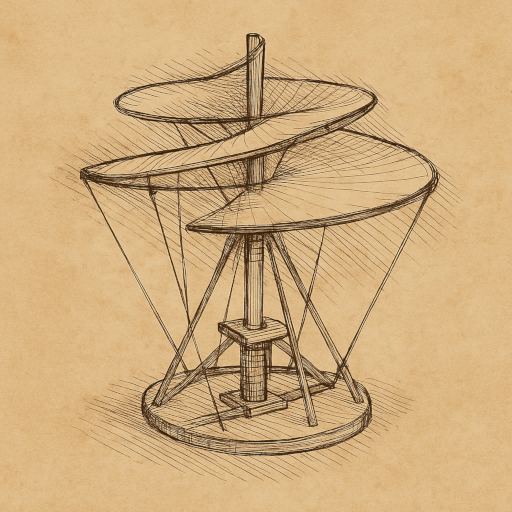The Renaissance Blueprint That Wouldn’t Work—Until Now
For centuries, Leonardo da Vinci’s “aerial screw” was a symbol of genius ahead of its time — brilliant, but doomed to fail. The sketch, drawn around 1480, showed a spiral rotor meant to lift a platform into the air. It looked like a corkscrew made of linen, reed, and wire — a flying machine that would twist itself skyward.
In theory, it was the world’s first helicopter. In practice, it never left the ground. The materials were heavy, the power source was human muscle, and the physics were only partly understood. For 500 years, the aerial screw was admired as art rather than engineering. But recently, something remarkable happened: modern scientists discovered that Leonardo’s design wasn’t just visionary — it might actually outperform some of our modern propellers.

The Return of a Forgotten Design
At Johns Hopkins University, engineers decided to test the aerial screw with tools Leonardo could only have imagined — supercomputers and fluid dynamics simulations. They recreated his spiral rotor virtually, then placed it in a digital wind tunnel to see how it behaved in the air.
The results were surprising. The aerial screw produced as much lift as a standard drone propeller but did so at a lower rotation speed. That means it could fly using less noise and gentler airflow — two things modern drones struggle with.
It turns out that Leonardo’s intuition was right all along. His helical design pushes against air in a smoother, more continuous motion than modern multi-blade rotors, spreading the aerodynamic forces evenly instead of chopping the air into sharp vortices. That makes it both efficient and quiet — qualities any engineer designing city-friendly drones would celebrate today.
How a Spiral Defies Modern Expectations
Most of today’s propellers slice through the air like knives, generating small tornadoes at their blade tips. These turbulent vortices are what produce the high-pitched buzzing sound we associate with drones.
Leonardo’s spiral takes a different path. Because its surface is continuous, air flows more gradually around it. The vortex energy that usually escapes at blade edges is dispersed along the spiral’s curve, creating less turbulence and less noise.
In other words, it doesn’t hack through the air — it glides through it. The slower spin helps too: a lower rotation speed reduces both energy use and acoustic intensity. The result is a design that trades a little aerodynamic efficiency for a big gain in silence.
It’s a rare balance — a rotor that sacrifices speed for serenity. And in a world filling with delivery drones and aerial taxis, that balance could be invaluable.
From Sketch to Simulation to Sky
The idea isn’t just theoretical anymore. Engineers at the University of Maryland have already built flying prototypes inspired by Leonardo’s sketches. These small drones use spiral rotors based on the aerial screw’s geometry — and they work. Modern materials like carbon fiber and lightweight polymers make the design feasible for the first time in history.
Meanwhile, researchers at Johns Hopkins are refining the concept further, exploring how variations in the spiral’s pitch and diameter could make future rotors even quieter. Their findings suggest a future where drones hover with a soft hum instead of a shrill buzz — a world where cities could accept aerial technology without the noise pollution that drives residents mad.
Leonardo couldn’t have predicted electric motors, sensors, or GPS, but his understanding of air movement was astonishingly accurate. He imagined air as a living medium that could be “grasped” by the right geometry — an idea that still guides modern aerodynamics.
The Broader Promise of the Aerial Screw
Quiet drones are just the beginning. The same principles could reshape how we design everything that spins — from fans and ventilation systems to underwater propellers and wind turbines. A spiral that moves air or water more gently could make these machines less disruptive and more efficient.
There’s even talk of applying similar ideas to electric vertical takeoff aircraft — the flying taxis being tested for future cities. Noise is one of their biggest obstacles, and a helical rotor inspired by Leonardo’s work might be a step toward solving it.
Across centuries, the aerial screw reminds us that progress doesn’t always move forward in a straight line. Sometimes it spirals — looping through history, rediscovered by those who finally have the tools to make old dreams real.
When Imagination Outruns Time
Leonardo da Vinci was never just drawing machines; he was sketching possibilities. His aerial screw, dismissed as fantasy for half a millennium, turns out to hold clues to one of today’s most modern challenges: making flight quieter, cleaner, and more graceful.
It’s poetic that a Renaissance inventor — with ink, paper, and boundless curiosity — might help us build better drones and calmer cities. The aerial screw’s rebirth shows how imagination can outlast technology, waiting patiently for science to catch up.
As we explore new ways to fly, it’s worth remembering that some of the best ideas are already written down — just waiting for the right century to take off.
To not miss out on fresh articles, useful tips, and exclusive materials, I suggest subscribing to the newsletter:
Thank you for your attention, Lumin Hopper
Sources:
- Leonardo da Vinci’s aerial screw background – Wikipedia
- Limitations of the 15th-century design – COVE Leonardo da Vinci’s Aerial Screw
- Modern CFD research findings – Johns Hopkins Univ. (Lisa Ercolano, JHU Hub); Futurity (Johns Hopkins); Holistic.news (Mateusz Tomanek) holistic.news
- Noise and aerodynamics analysis – Futurity; JHU Hub
- Prototype and modern context – Wikipedia


